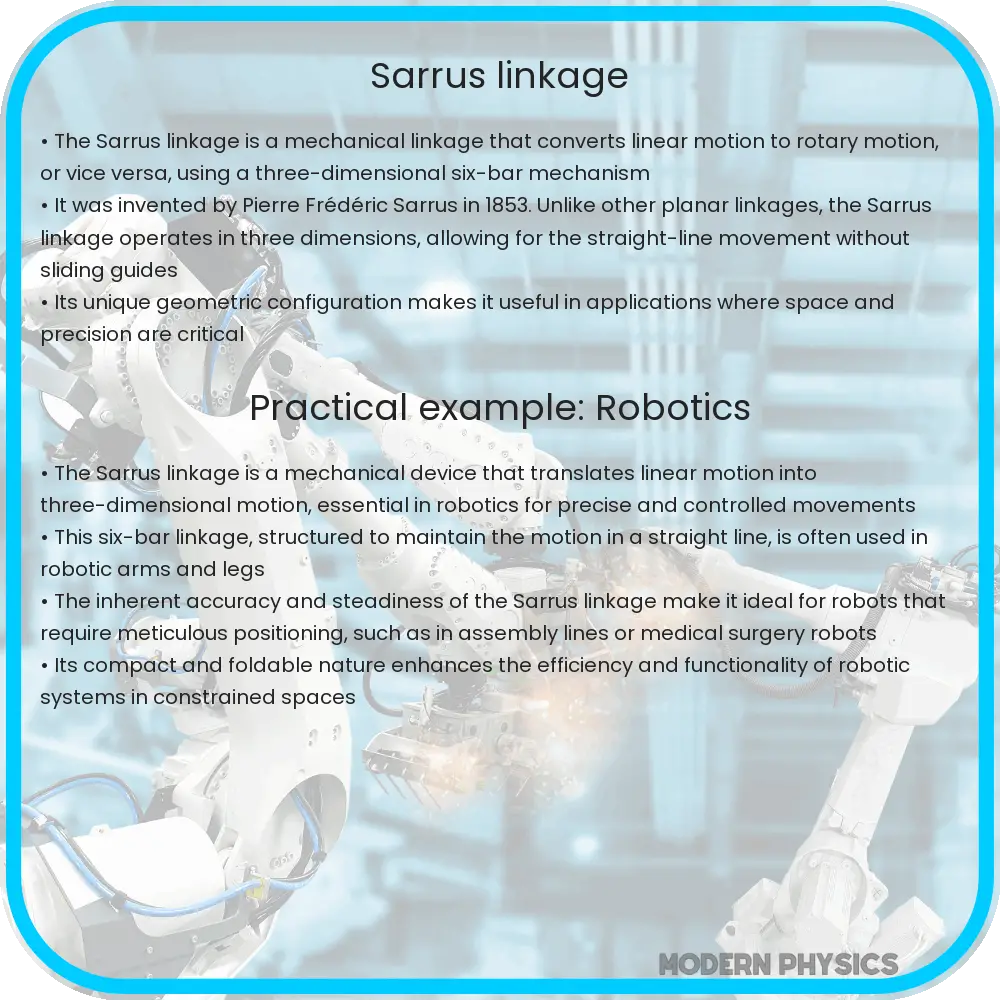Learn about the Sarrus linkage, a mechanical mechanism converting linear motion to straight-line motion efficiently.

Understanding the Sarrus Linkage: A Fascinating Mechanical Mechanism
The Sarrus linkage, named after the French mathematician Pierre Frédéric Sarrus, is a relatively simple yet intriguing example of a spatial linkage. Its primary function is to convert linear motion to nearly perfect straight-line motion in a plane perpendicular to its folding mechanism without the need for guide surfaces or sliding pairs. Let’s delve into the mechanics of the Sarrus linkage and explore its unique way of achieving linear motion.
The Structure of Sarrus Linkage
The Sarrus linkage consists of three parallel pairs of links where each pair is connected by pivots. The pairs are joined in such a way that they form two parallelograms, which allow the motion to remain within a specific plane. This clever design avoids the complexity and friction that traditional sliding mechanisms involve.
To better visualize it, imagine two identical pieces set parallel to each other, connected by perpendicular bars that act as links. These links pivot in such a way that the motion of one bar drives the entire structure. The beauty of the Sarrus linkage lies in its simplicity, enabling straightforward assembly and maintenance.
How the Sarrus Linkage Works
The linkage operates on a principle where each joint connection allows for rotation in a way that restricts the overall motion of linking bars to linear translation. As one end of the linkage is moved, the constraints formed by the geometrical layout of the links ensure that the opposite end moves linearly in either direction. This provides a stable, straight path, which is the hallmark of the Sarrus mechanism.
The kinematics of the Sarrus linkage can be analytically described by the parameters of its assembly. The lengths and angles of the bars dictate how far and in which direction the motion will be purest. These parameters are crucial for optimizing the linkage to accomplish the desired motion efficiently.
Applications of Sarrus Linkage
The applications of the Sarrus linkage are widespread in scenarios where precise linear motion is required. It is used in various engineering fields, including robotic arms, mechanical actuators, and telescopic mechanisms. The accuracy and reliability of the Sarrus linkage make it a preferred choice in precision engineering tasks.
In robotic arms, for instance, the linkage helps in achieving linear motion to position tools or sensors accurately without complex control systems. Meanwhile, in mechanical actuators, it assists in converting rotational motion obtained from motors into linear output, which is essential for operations like automated opening and closing actions.
The principle of Sarrus linkage is also applied in foldable structures. The linear motion property is advantageous in devices that require compact storage capabilities but expand to a full size when deployed. This makes it ideal for applications ranging from space-saving furniture designs to compactly stowed tools and apparatus in industrial and consumer products.
The Sarrus linkage not only demonstrates a significant application of kinematic principles but also serves as an inspiration for designing novel mechanisms that require compact and precise motion control. As we continue to explore and understand these mechanisms, the potential for innovative applications in modern engineering expands, highlighting the importance of kinematics in the development of functional and efficient mechanical designs.
Key Considerations in Designing Sarrus Linkages
When designing a Sarrus linkage, several key factors must be considered to ensure its optimal performance. Firstly, the material selection is critical as different materials will affect the durability, flexibility, and overall weight of the assembly. Materials commonly used include metals for high-strength applications and plastics for lightweight or disposable mechanisms.
Another consideration is the precision in the manufacturing process. The joints and pivots in the Sarrus linkage require high precision to maintain the integrity of the linear motion. Any small deviation can lead to errors in the motion path, affecting the mechanism’s effectiveness.
Lastly, the design must also take into account the environment in which the linkage will operate. Factors such as temperature fluctuations, presence of dust or liquids, and mechanical loads can significantly influence the performance and lifespan of the linkage. Protective coatings or sealed designs might be necessary to mitigate such environmental impacts.
Future Prospects of the Sarrus Linkage
The ongoing advancements in material science and precision engineering continue to broaden the applications of the Sarrus linkage. With the integration of smart materials, which can react to environmental stimuli such as changes in temperature or electric fields, the Sarrus linkage could be adapted for more responsive and adaptive applications.
Additionally, the development of microfabrication technologies paves the way for miniaturized Sarrus linkages. These could be critical in micro-electromechanical systems (MEMS), enabling new capabilities in compact devices such as medical implants and wearable technology.
As engineers and designers continue to innovate, the versatility and adaptability of the Sarrus linkage will likely find new applications in areas yet to be envisioned, pushing the boundaries of what is mechanically possible.
Conclusion
The Sarrus linkage, with its elegant yet simple mechanism for achieving nearly perfect linear motion, illustrates the power of mechanical engineering to solve complex problems through clever design. From robust industrial machines to delicate robotic components, this linkage plays a crucial role in various applications requiring precise linear translation. By understanding the principles and mechanics behind the Sarrus linkage, we can appreciate the depth of thought and creativity involved in mechanical design. Whether in current applications or future innovations, the Sarrus linkage continues to be an indispensable component in the evolution of mechanical and robotic systems. As we explore further into the realms of precision engineering and kinematics, mechanisms like the Sarrus linkage will remain at the heart of many groundbreaking technological advancements.
